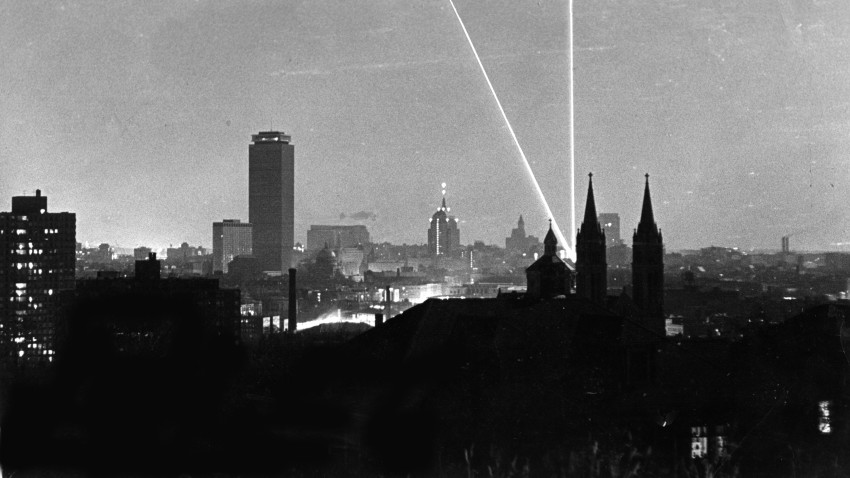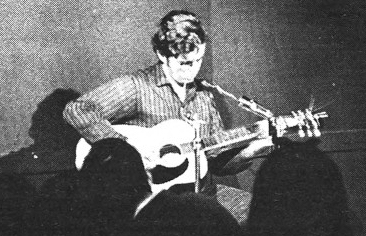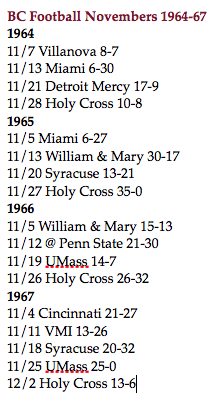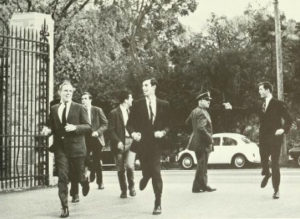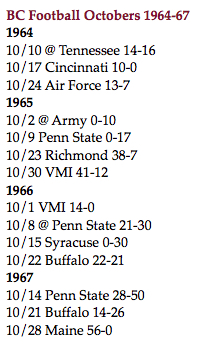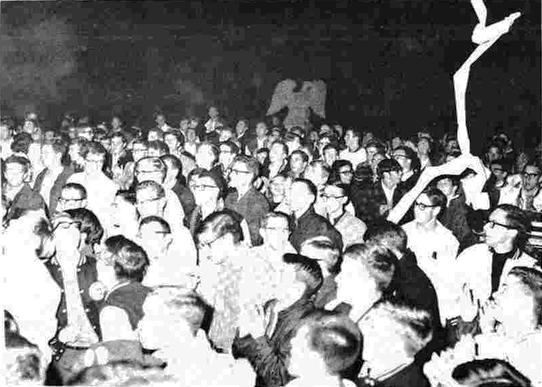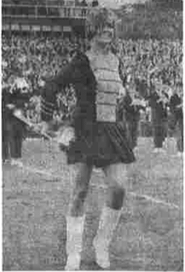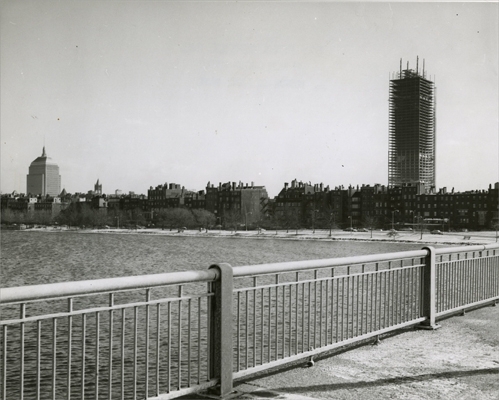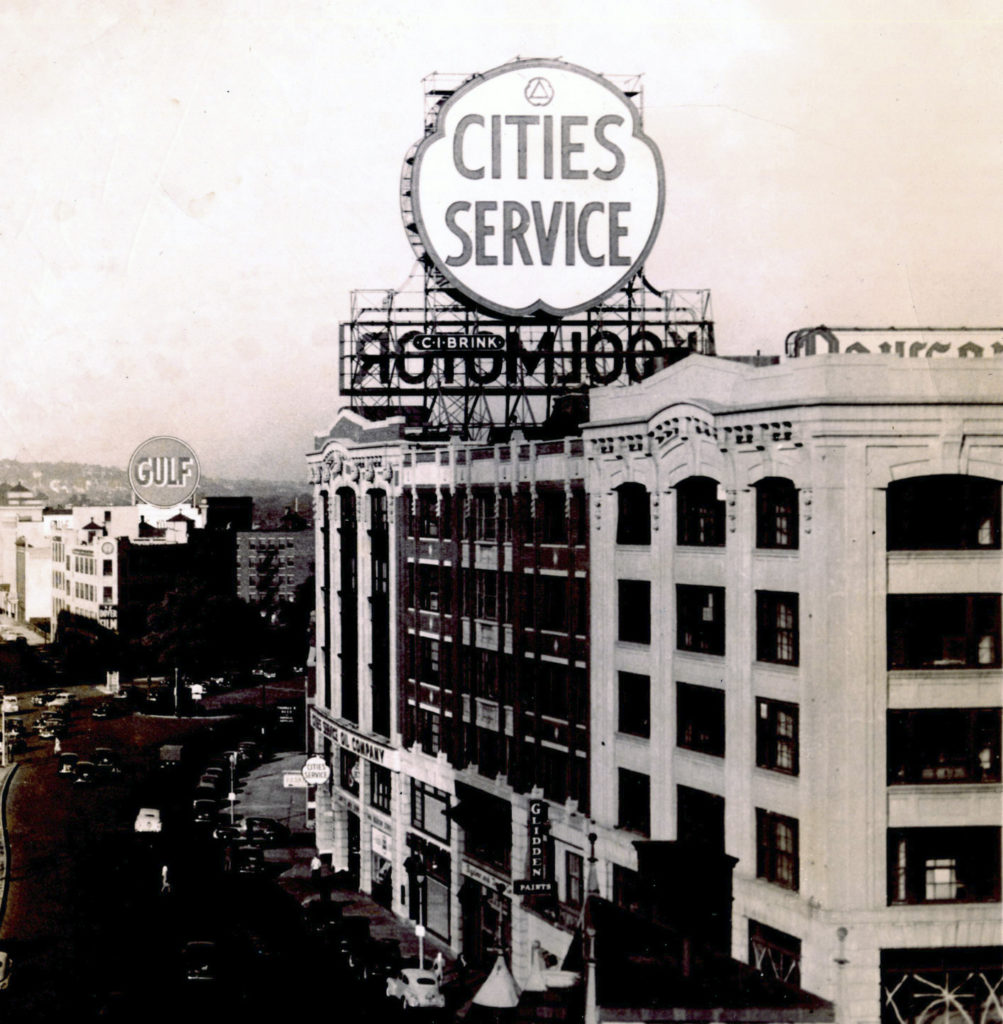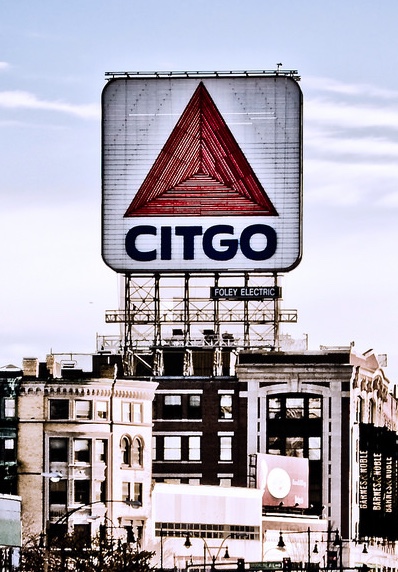Some of the things that happened those first few weeks of school each September, 1964-67.
On campus
1964
Carney Faculty Center was dedicated on the 17th. It was one of the few buildings at BC not named after a Jesuit. Andrew Carney was a Irish immigrant to Boston who donated $5,000 to John McElroy, S.J., and covered all the construction costs of Boston College and the Church of the Immaculate Conception in the South End in the late 1850s. Heights
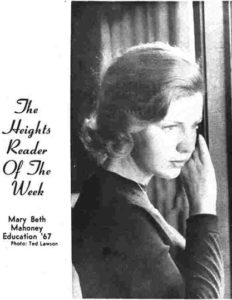
The September 25, 1964 edition of the Heights introduced us to “The Heights Reader of the Week”
John Willis, SJ, was appointed dean of A&S. He succeeded John Long, SJ, who had been named dean in the summer, but died suddenly in July. Other appointments announced were George Drury, SJ, as executive assistant to the president; Edward Hanrahan, SJ, as dean of resident men; and Alfred Jolson, SJ, as associate dean of CBA. Fr. Jolson also became moderator of the Campus Council.
In an interview with the Heights, Fr. Hanrahan said curfews and other regulations were in place “to provide good conditions” and they should be considered guideposts and not harassment. The article also notes that dorm residents among the senior class had declined to about 170 students.
An advertisement in the Heights for the Algonquin Package Store offered “ice cubes for rent,” with fast, free delivery “in plain brown wrappers by unmarked sedan.”
1965
This year, Fr. Drury was in a post, new both to BC and him — director of student personnel services. The new office oversaw admissions, extracurricular activities, housing and resident student affairs, health services, and programs for international students.
The Mass of the Holy Spirit that traditionally marked the beginning of the academic year was for the first time a concelebration, by Michael Walsh, SJ, BC president, and seven other Jesuit faculty members. It took place, the Heights said, because of the liturgical changes brought about by Vatican II.
We learned that two classmates — Francis Piatti and John Duffney — had been killed in auto accidents during the summer.
More in the Heights
1966
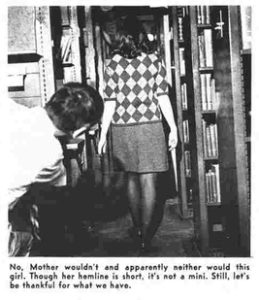
The September 30, 1966, Heights asks “But Would Mother Wear a Mini” and acknowledges in its caption that this skirt is not a mini. ?
Students returned to find the popular chairman of the Classics Department, Robert Healey, SJ, gone. Fr. Walsh had dismissed the untenured professor in late June and Fr. Healey was apparently, according to the Heights, teaching at Fairfield University, which, at the time, had no classics department.
Margo, the eagle BC used as a mascot at football games, had died recently in her cage at her home, Franklin Park Zoo. Efforts were underway to find a replacement.
1967
“Romney due at BC this morning” was the headline in the September 29 edition of the Heights. Described as the “leading Republican presidential hopeful,” Governor George Romney came to talk with BC faculty about urban problems. George Romney was Mitt Romney’s father.
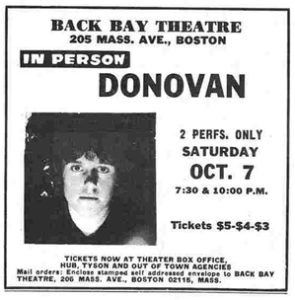
Ad from the September 29, 1967, Heights. Note ticket prices.
Seniors (that was us) were reminded they could have Sub Turri photos taken until October 13.
Army football played BC for the first time in Chestnut Hill on September 30. The six previous games between the two institutions had all been at West Point and all had been Army victories. Army had played in Boston or Cambridge 17 previous times, against Harvard in 16 games and BU once. Change of venue didn’t make a lot of difference. It was Army 21, BC 10.
In the outside world
1964
It was in August of that year that the US Congress passed the Gulf of Tonkin resolution, a joint resolution providing President Lyndon Johnson the authority to do “whatever necessary” to retaliate for reported North Vietnamese attacks on US Navy destroyers and to protect any Asian ally. Two senators voted against it.
Premiering on television that September were Shindig and Bewitched on ABC and Man from Uncle on NBC. You can actually find videos of some/most/all of those programs on YouTube.
1965
That summer, LBJ signed the Voting Rights Act, Satisfaction had been released by the Rolling Stones, LBJ signed a bill requiring that warnings be printed on cigarette packs, US troops received orders to operate offensively in South Vietnam, Bob Dylan released Like a Rolling Stone and went electric at the Newport Folk Festival, and the US Supreme Court ruled that married couples could use contraceptive products.
The Today Show for the first time was broadcast entirely in color in September. Other shows premiering that month were F-Troop, Lost in Space, Hogan’s Heroes, Get Smart, and I Dream of Jeannie.
1966
That summer, civil rights activist James Meredith had been shot by a white sniper in Mississippi, the NFL and American Football League announced their merger, the US Supreme Court announced its Miranda decision, US planes bombed Hanoi and Haiphong for the first time, Charles Whitman shot 42 people (killing 11) from the University of Texas’s tower, and the Beatles held their last public concert in Candlestick Park, San Francisco.
Labor Day weekend was the first Jerry Lewis Muscular Dystrophy telethon. Premiering this month on television were Star Trek (NBC), That Girl (ABC), and The Monkees (NBC). Chevrolet introduced the Camaro.
1967
During that “long hot summer,” there were riots in Roxbury, Mass, as well as in 12 other communities, with major conflicts in Newark, N.J., and Detroit, Mich.; Israel and neighboring Arab states fought “The Six-Day War”; the Monterey Pop Festival took place; Red Sox star Tony Conigliaro was beaned during the team’s iconic run for the World Series title; and the last episode of The Fugitive attracted millions of viewers.
The United State and the Union of Soviet Socialist Republics conducted numerous tests of nuclear weapons tthroughout the month.
Mission Impossible premiered on CBS.

